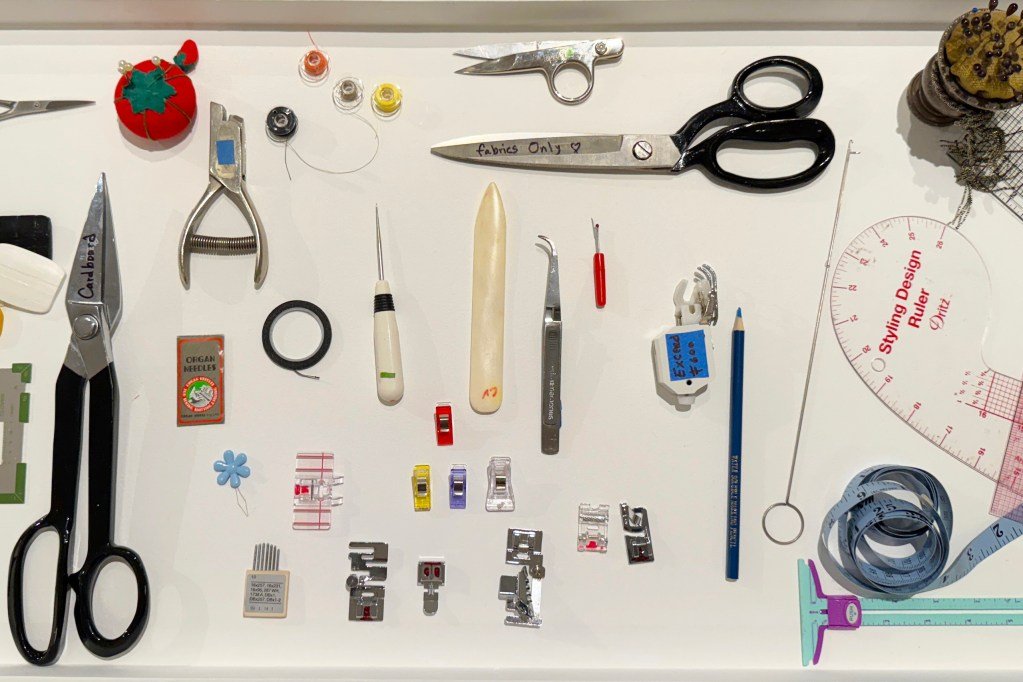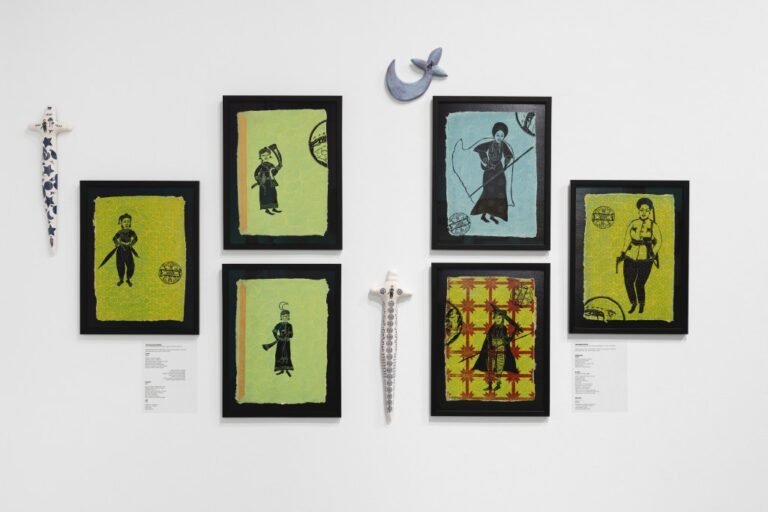

CLAREMONT, California — Entering the Lenzner Gallery at Pitzer College feels like stepping into Carmen Argote’s walk-in closet. In this section of her two-part solo exhibition, gajes del oficio, the multidisciplinary artist has hung 22 jumpsuits along a lengthy curtain rod. Visitors have to shuffle around the garments along a narrow path to get a good look. Each article of clothing is made from the same sewing pattern, but they gain their own personalities via vintage fabrics, hodgepodge buttons, and any number of pockets. This capsule wardrobe, elevated to maximalist absurdity, is the artist’s tribute to her family matriarchs.
Argote was born in Mexico; in the 1980s, her relatives immigrated to Los Angeles, where her grandmother began to work as a seamstress. That skill was passed down to Argote’s mother, Carmen Vargas, and then to the artist herself. Before this exhibition, Argote wasn’t yet a proficient sewer, so she sought her mother’s mentorship to transform generational knowledge into an art form.

Unlike the monotonous garments that her relatives had to manufacture for their jobs, Argote chooses individuality, and distinguishes each item in her Jumpsuits/Carmen Argote Wardrobe series (2025) through fabrics that feature motifs like ditsy florals, painterly dragonfruit, and colorful plants, rendered in traditional Mexican embroidery techniques. Though Argote made these for herself, they feel like an attempt to humanize the assembly line. Perhaps this is how clothing would look if garment workers could imbue each product with their personality.
Alongside the clothing, the gallery showcases the jumpsuit pattern that spawned the others, and cutting tables filled with Carmen Vargas’s sewing supplies and knickknacks. The installation “partially finished garment: top” (2025), which showcases a jumpsuit’s striped fabric cut lined up against the pattern’s collar segments, appears freshly touched, as if Argote and her mother simply stepped away to take a break during their sewing frenzy.
In the corner of the space is “overcast mounted jumpsuit” (2025), a length of muted gray canvas that spills down the wall and onto the floor. The front and back of the jumpsuit are appliqued onto it, split from the neck like a banana peel. The shared collar protrudes, as if a body was emerging from the surface.

This eerie work is the basis for the show’s other half, located across campus in the Nichols Gallery. In this room, Argote focuses more broadly on the jumpsuit’s role as a working class uniform. “Gajes del oficio” (2025) unfolds from the ceiling like a scroll. An abstracted variation of this outfit, now made from a semi-sheer peach polyester organza, marches in a massive daisy chain across the gallery floor. Argote has tucked lemons into some of the pockets, which she harvested from Pitzer’s campus and farms around the Inland Empire. As the fruit decomposes, it leaks its acidic juice onto a hand-dyed paper placed underneath the jumpsuits. A chemical reaction causes the dye to change color, matching the pink fabric.
Even when laid flat, the collars bob up. It’s like a magician went out to an orchard and performed a massive vanishing act — poof! — and each laborer left their uniforms behind. Except now, the magicians are ICE agents, and the workers might never return to raucous audience applause.
The lemon stains add to the oil paper’s texture and complexity, creating a more interesting artwork. Without it, the paper feels dull and unfinished. This becomes a metaphor for the imprint that undocumented people have left on our communities. They enrich the lives, culture, and economy of others, and we are less cultivated without them.






Carmen Argote: gajes del oficio continues at the Pitzer College Art Galleries (1050 North Mills Avenue, Claremont, California) through December 6. The exhibition was organized by the institution.


